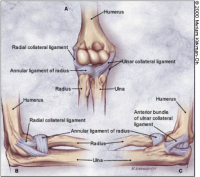Elbow Varus Stress: Difference between revisions
Rachael Lowe (talk | contribs) m (Text replace - '<references /> ' to '<references /> {{Template:Disclaimer}}') |
Kim Jackson (talk | contribs) (Updated categories) |
||
| (22 intermediate revisions by 11 users not shown) | |||
| Line 1: | Line 1: | ||
< | <div class="editorbox"> | ||
'''Original Editor '''- [[User:Tyler Shultz|Tyler Shultz]] | |||
'''Top Contributors ''' - {{Special:Contributors/{{FULLPAGENAME}}}}</div> | |||
== Purpose == | |||
The purpose of the varus stress test of the elbow is to assess the integrity of lateral collateral ligament.<br> | |||
[[Image:Elbow Ligaments.png|thumb|right|200px|Elbow Ligaments]] | |||
== Technique == | |||
With the patient is standing, the therapist places the patient's elbow in slight flexion while palpating the humeroulnar joint line. The therapist then applies a varus force to the elbow. This test is considered positive if the patient experiences pain or excessive laxity is noted and compared to the contralateral side.<ref>Flynn, T.W., Cleland, J.A., Whitman, J.M. (2008). User's guide to the musculoskeletal examination: Fundamentals for the evidence-based clinician. Buckner, Kentucky: Evidence in Motion</ref> The test can be repeated in varying degrees of elbow flexion, but generally it is positioned between 5 and 30 degrees.<ref>Dutton, M. (2008). Orthopaedic: Examination, evaluation, and intervention (2nd ed.). New York: The McGraw-Hill Companies, Inc.</ref><br><br> | |||
{{#ev:youtube|rcIGQ7daGek|300}}<ref>CR Technologies. Varus Stress Test - Elbow (CR). Available from: http://www.youtube.com/watch?v=rcIGQ7daGek [last accessed 26/03/14]</ref> | |||
== References == | |||
<references /> | |||
[[Category:Special_Tests]] | |||
[[Category:Elbow]] | |||
[[Category:Assessment]] | |||
[[Category:Elbow - Assessment and Examination]] | |||
[[Category:Ligaments]] | |||
[[Category:Musculoskeletal/Orthopaedics]] | |||
[[Category:Primary Contact]] | |||
[[Category:Sports Medicine]] | |||
[[Category:Athlete Assessment]] | |||
[[Category:Elbow - Special Tests]] | |||
Latest revision as of 19:51, 31 January 2021
Original Editor - Tyler Shultz
Top Contributors - Rachael Lowe, Admin, Kim Jackson, Tyler Shultz, Laura Ritchie, Redisha Jakibanjar, Tony Lowe, Evan Thomas, Kai A. Sigel, WikiSysop, Claire Knott and Wanda van NiekerkPurpose[edit | edit source]
The purpose of the varus stress test of the elbow is to assess the integrity of lateral collateral ligament.
Technique[edit | edit source]
With the patient is standing, the therapist places the patient's elbow in slight flexion while palpating the humeroulnar joint line. The therapist then applies a varus force to the elbow. This test is considered positive if the patient experiences pain or excessive laxity is noted and compared to the contralateral side.[1] The test can be repeated in varying degrees of elbow flexion, but generally it is positioned between 5 and 30 degrees.[2]
References[edit | edit source]
- ↑ Flynn, T.W., Cleland, J.A., Whitman, J.M. (2008). User's guide to the musculoskeletal examination: Fundamentals for the evidence-based clinician. Buckner, Kentucky: Evidence in Motion
- ↑ Dutton, M. (2008). Orthopaedic: Examination, evaluation, and intervention (2nd ed.). New York: The McGraw-Hill Companies, Inc.
- ↑ CR Technologies. Varus Stress Test - Elbow (CR). Available from: http://www.youtube.com/watch?v=rcIGQ7daGek [last accessed 26/03/14]







